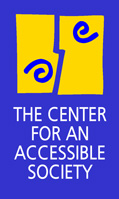
DISABILITY
ISSUES
INFORMATION
FOR
JOURNALISTS
TOPICS
ABOUT
THE CENTER
In recent years a number of efforts to develop conceptual frameworks to organize information about disability have been initiated.
Prevailing definitions, based in statute and supporting program authorities, clearly do not reflect new paradigm concepts of disability. Nearly all definitions identify an individual as disabled based on a physical or mental impairment that limits the person's ability to perform an important activity. Note that the complementary possibility--that the individual is limited by a barrier in society or the environment--is never considered. . . .
It is useful to regard an individual with a disability as a person who requires an accommodation or intervention rather than as a person with a condition or impairment. This new approach derives from the interaction between personal variables and environmental conditions. Because accommodations can address person-centered factors as well as socio-environmental factors, a ``need for accommodation'' is a more adaptable concept for the new paradigm.
The various definitions of disability that have formed the basis for both program eligibility and survey data collection Among these efforts are:
(1) The International Classification of Impairments, Disabilities, and Handicaps, which was developed in 1980 by the World Health Organization
The ICIDH is a manual issued by the WHO in 1980 as a tool for the classification of the consequences of disease, injury, and disorder, and for analysis of health-related issues.The ICIDH was designed to provide a framework to organize information about the consequences of disease. An ongoing revision process is considering social, behavioral, and environmental factors to refine the concept of ``handicap.'' "Classifications of diseases fail to capture the variety of experiences of people who live with health conditions, and the ICIDH was designed to fill that gap," says the WHO.
(2) The "Nagi model'':
The Institute of Medicine in 1997 stated that disability is a function of the interaction of individuals with the social and physical environments. The revised "Nagi model" (From "Disability Concepts Revisited: Implications for Prevention," by S.Z. Nagi, which was presented by the Institute of Medicine in its 1991 Disability in America report (Disability in America: Toward A National Agenda for Prevention by A.M. Pope and A.R. Tarlov (Eds.), 1991, Washington, DC: National Academy Press) describes the environment as including the natural environment, the built environment, culture, the economic system, the political system, and psychological factors. The new model includes a state of ``no disabling condition.''
The state of disability is not included in this model because disability is not viewed as inherent in the person, but rather as a function of the interaction of the individual and the environment
(3) The schematic adopted by the National Center for Medical Rehabilitation Research (NCMRR) in its Research Plan (1993, p. 33) added the concept of societal limitation.
None of these, though, has explanatory power for research purposes.
OTHER ITEMS OF INTEREST:
The following sites contain information that may be of interest. Please bear in mind that the information at these sites is not controlled by the Center for An Accessible society. Links to these sites do not imply that the Center supports either the organizations or the views presented.
The Disability Statistics Center at the University of California/San Francisco is funded primarily by The National Institute on Disability and Rehabilitation Research to provide statistical information on disability and the status of people with disabilities.
The following information is available from InfoUse:
Chartbook on Women and Disability in the United States
Chartbook on Work and Disability in the United States
The latest publication in the Chartbook series, "Chartbook on Women and Disability in the United States," is a reference on national statistical information on gender and disability. All the charts and text from this chartbook are available on-line, and you may also download the entire chartbook in PDF format for printing. Last updated: 07/21/99.
InfoUse has recently published the "Chartbook on Work and Disability in the United States," a reference on national statistical information on work disability. All the charts and text from this chartbook are available on-line, and you may also download the entire chartbook in PDF format for printing. Last updated: 03/19/99. Note: Some charts have been updated with 1998 CPS data. Chartbook on Disability in the United States
InfoUse has published a revision of its "Chartbook on Disability in the United States," a reference on national statistical information on disability. This section of our Web site includes Chartbook excerpts, with an electronic version of the entire chartbook available for downloading in PDF format. Last updated: 11/12/98.
Overview
The 'new paradigm' of disability
One in 5 working-age people reports a disability
Read Deborah Kaplan on the definitions of disability
Research on disability definitions from NIDRR